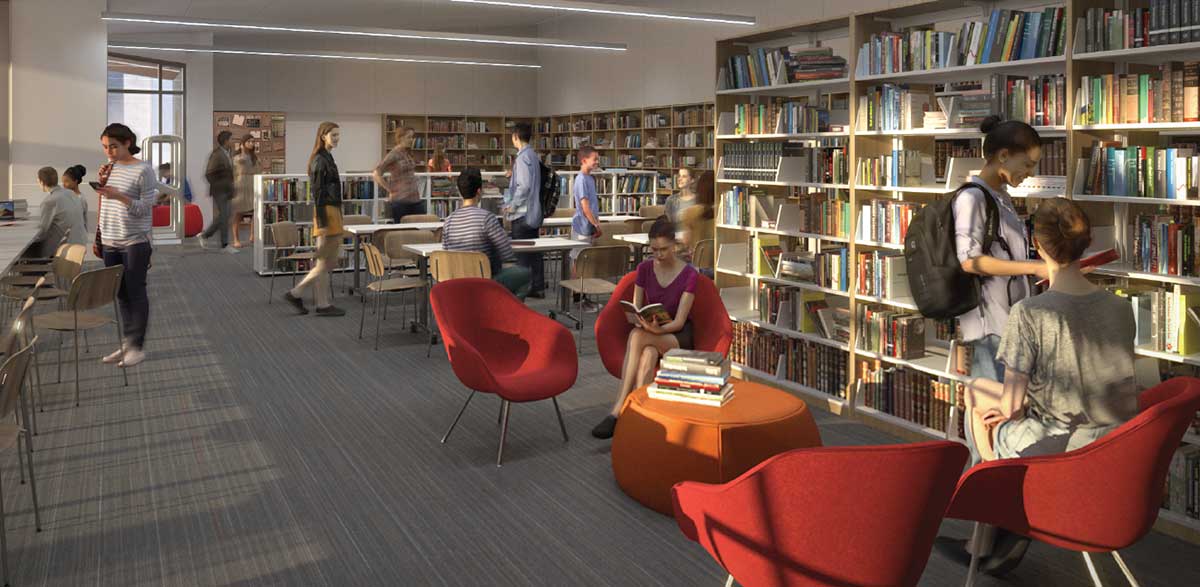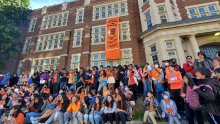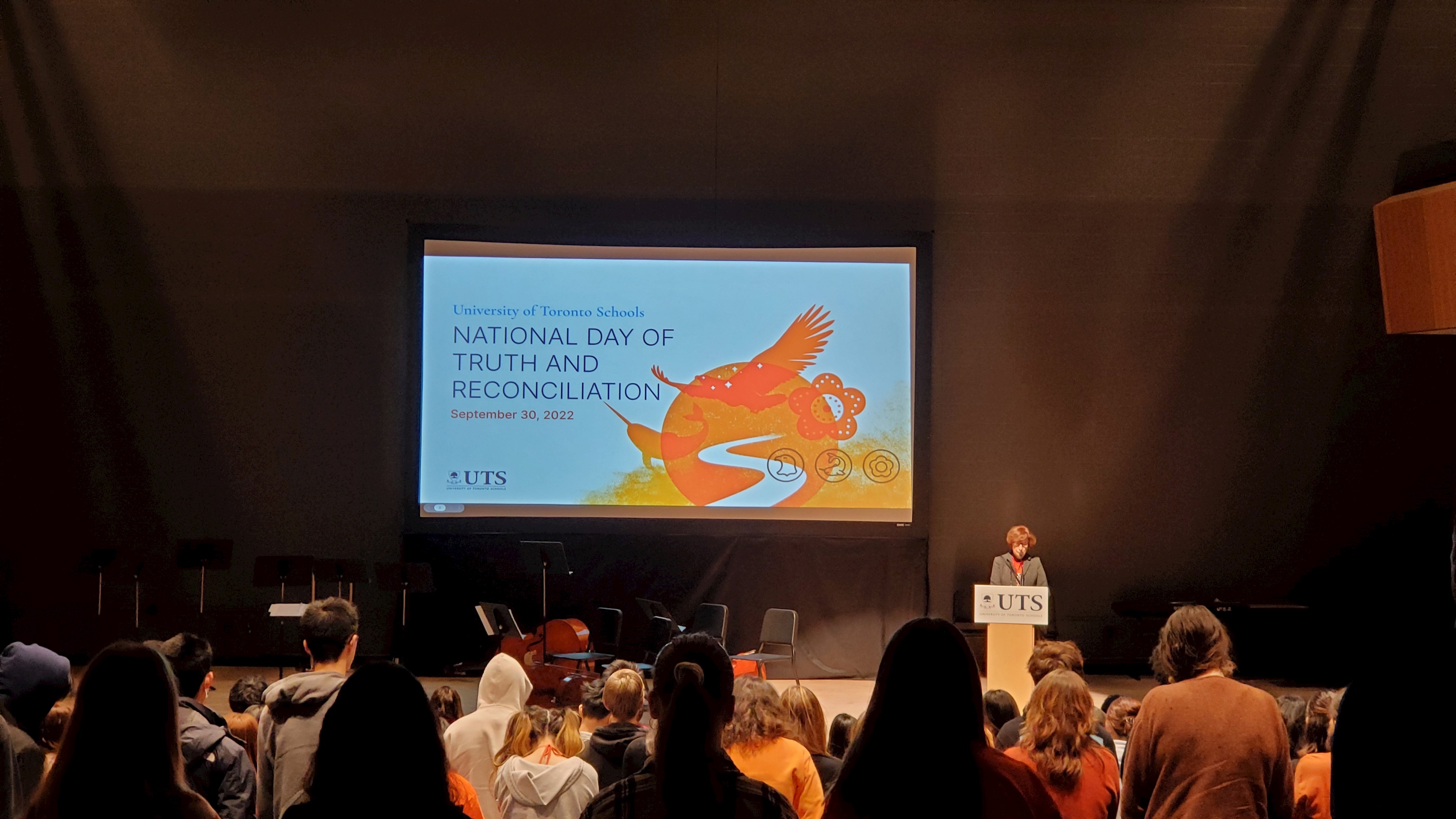371 Bloor Street West
Toronto, ON M5S 2R7 get directions
Toronto, ON M5S 2R7 get directions



How do we take real action toward Reconciliation? University of Toronto Schools (UTS) took the National Day for Truth and Reconciliation one step further this year, devoting the entire day to learning and reflecting about the history of Indigenous peoples in Canada, the truths of residential schools and the actions we can take to help further Reconciliation in our country. Regular classes were cancelled. A school-wide assembly featured keynote speaker Brianna Olson-Pitawanakwat, an Indigenous Birthworker, artist and member of Wikwemikong Unceded First Nation, sharing grim statistics, painful history and hope. Collaboration and community thrived as students attended afternoon workshops on treaties, the Mohawk language, Indigenous canoe culture and the Medicine Wheel, watched films about residential schools and learned through the power of art and nature.

Keynote speaker Brianna Olson-Pitawanakwat, an award-winning community leader, Indigenous Birthworker, artist and member of Wikwemikong Unceded First Nation.
Residential schools are only part of a much a bigger story, and we need to understand the larger history while acknowledging and valuing Indigenous contributions to our country, keynote speaker Brianna Olson-Pitawanakwat told UTS students from the podium stage in the Withrow Auditorium, launching an entire day of Reconciliation activities at the school.
“The explorer’s doctrine of discovery operated under the legal principle of terra nullius. This translates as no man’s land…” said Olson-Pitawanakwat, an award-winning leader and social worker who is a founding member of the Toronto Indigenous Harm Reduction Collective. “They came here with the idea that there was nobody here, that it was an empty continent.” That wasn’t true.
An Indigenous Studies professor, she walked students through colonial history, describing Canada’s Gradual Civilization Act of 1857 as treating Indigenous peoples like they were less than human. The Indian Act followed in 1876, taking away human rights, banning governance and ceremonies, and prohibiting gatherings – no more than three Indigenous people were allowed to be together in one place at a time. Longhouses were burned, potlatches banned and Indigenous peoples relegated to reserves, living on only a fraction of their homelands.
“You can’t thrive without land,” Olson-Pitawanakwat said. A member of Wikwemikong Unceded First Nation, a multimedia artist and jingle dancer, her people have lived on Manitoulin Island – which they call Spirit Island – since “time immemorial,” having “as many homes as there only countries in the world that has race-based legislation. And that is not right.”
She spoke of a standing joke among Indigenous peoples: the $5 per year many Anishnabeg still receive from the Huron-Robinson Treaty, signed in 1850 and never adjusted for inflation.
“A few years ago, the Huron-Robinson Treaty was revisited in court. The Anishnabeg took the Ontario and Federal governments to court and sued them and won…” said Olson-Pitawanakwat. “What we are seeing all across Turtle Island is Indigenous peoples are asserting their fundamental rights within provincial courts, the federal court, the Supreme Court and internationally with documents like the United Nations Declaration on the Rights of Indigenous Peoples.”
Olson-Pitawanakwat called on students to become allies and supporters of Indigenous peoples in these efforts, and said, “We need to acknowledge and value Indigenous contributions to this country.” She cited democratic traditions that Canadians live by today which had their origins in the Haudenosaunee longhouse, or how some of the longest-standing peace treaties in the world were created by Indigenous peoples, right here in Ontario.
Her keynote highlighted painful truths and hard statistics not just about the past, but about the present. Sixty per cent of Indigenous peoples in Toronto live in poverty. There are 75 Indigenous communities in Canada without access to clean water. Children off-reserve receive almost 20 per cent more funding for education than children on reserves.

UTS Principal Rosemary Evans at the National Day for Truth and Reconciliation Assembly.
The morning assembly set the tone for a day of learning and reflection at UTS, organized by the school’s Indigenous Solidarity Committee leaders, staff and administration. “We wanted this day to be a disruption of business as usual,” said UTS Principal Rosemary Evans, “a day for all members of the UTS community to confront and continue learning the truth of the residential school system, to listen to Survivors, memorialize those who did not survive, and engage directly and deeply with our responsibility to respond to the ongoing impacts of Canada’s genocide and broken treaties.”
The assembly also included moving video testimonials from Residential School Survivors from CBC’s The National segment Stolen Children: Voices, a Land Acknowledgement by UTS Traditional Teacher Cat Criger, opening remarks from Principal Rosemary Evans, and a stirring rendition of Missing by Aboriginal composer Cris Derksen, played by UTS Chamber Strings under the direction of UTS Expressive Arts Department Coordinator Sarah Shugarman.

UTS Chamber Strings under the direction of UTS Expressive Arts Department Coordinator Sarah Shugarman.
In the afternoon, collaboration and community flourished as students attended workshops, exhibits and film screenings on different aspects of Indigenous cultures.
“The law and laws of place and space are not inherently just,” said How to be a Treaty Citizen workshop co-leader Dr. Kiera Brant-Birioukov, an Assistant Professor of Indigenous Curriculum and Pedagogy who was born and raised in Tyendinaga Mohawk Territory. “We're privileged to live in Canada and to know that it's a safe place to be. But the law has not always upheld and treated folks equally or with justice, particularly, as we know with Indigenous folks in Canada.”
Dr. Kiera Brant-Birioukov led the workshop with her husband, Dr. Anton Birioukov-Brant, a settler Russian immigrant, drawing from Indigenous perspectives on the Dish With One Spoon Treaty, formed between the Anishinaabe, Mississaugas and Haudenosaunee that bound them to share the territory and protect the land; the idea being that the land is the dish and we all share the spoon.
Dr. Anton Birioukov-Brant and Dr. Kiera Brant-Birioukov led the How to be a Treaty Citizen workshop.
In another workshop, students learned greetings and phrases in the Kanyen'keha (the Mohawk language) as well as ongoing efforts to preserve Indigenous languages from Kristi Talbot, a Registered Early Childhood Educator with over a decade of experience serving her Indigenous community in Fort Erie, Ontario.
The art of canoe building using raw materials from nature, and the rich Indigenous canoe culture came to light as students created their own miniature canoes under the guidance of artist John Ferris, a member of Constance Lake First Nation, and founder of Ed-Digenous Traditions
A Medicine Wheel workshop, led by UTS Traditional Teacher Cat Criger, introduced students to core concepts in Indigenous philosophies and worldviews, as well as medicines and methodologies. Other activities included a guided walk on the Humber River, where students learned about Indigenous ecological relationships with the land. Others toured exhibits at the Art Gallery of Ontario and the Royal Ontario Museum, or watched and de-briefed important films on residential schools, We Were Children and Muffins for Granny.
Even lunch was culturally themed, with stew, bannock and bear claws served by Tea-N-Bannock, an east end restaurant specializing in Indigenous cuisine.
.jpg)
Learning about Indigenous culture through the power of art at the Art Gallery of Ontario.
At the end of the day, as hundreds of UTS students gathered together outside in front of our school building for closing remarks, a National Day for Truth and Reconciliation banner hung on the front facade of our school.
UTS Traditional Teacher Cat Criger and UTS Indigenous Solidarity Committee leader S6 (Grade 12) Shreya address students at the end of the day.
UTS Indigenous Solidarity Committee leader S6 (Grade 12) Shreya, who was integral in organizing the day’s activities, spoke on the megaphone, calling on students to go beyond reflection and build on what they learned. “When you leave here today, I want you to take what you learned and share it with someone else… and also take action, whether that means writing a letter, reading a book to learn more or going to a community event, take action and make a change.”
Above her and the students was the banner with the words: learn the truth, honour the treaties, and change the future. This is what we hope to do.
